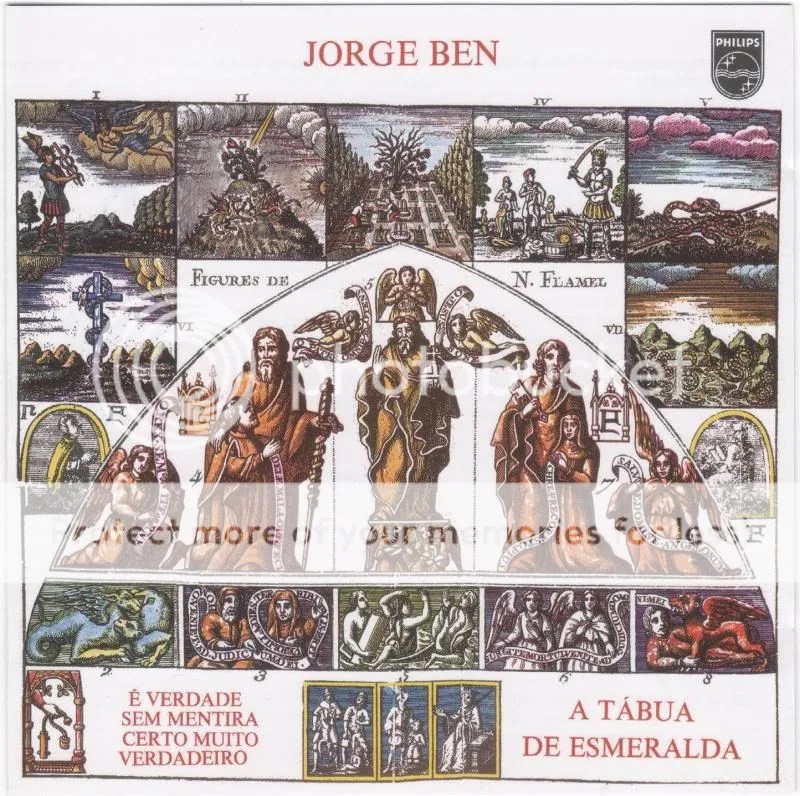

Jorge Ben
A Tábua de Esmeralda
Released 1974
Philips / Phonogram (6349 083)
This reissue – Salve, Jorge! Boxset (2009)
1 Os alquimistas estão chegando os alquimistas
2 O homem da gravata florida
3 Errare humanun est
4 Menina mulher da pele preta
5 Eu vou torcer
6 Magnólia
7 Minha teimosia, uma arma pra te conquistar
8 Zumbi
9 Brother
10 O namorado da viúva
11 Hermes Trismegisto e sua celeste Tábua de Esmeralda
12 Cinco minutos
I realized just the other day that I completely skipped over the marvelous ‘Força Bruta’ in my presentation of this new Jorge Ben box. Not sure how that happened, but I will remedy the situation soon (although the DGA reissue IS here, in fact it was one of the first posts ever on this blog).
This album obviously merits more spilled ink than I have given it here, but I am exhausted and this is a good album for rejuvenation, and it speaks well enough for itself. Many people think this is Jorge Ben’s best album ever. I am one of them, although I have decided of late that it is impossible to consider it as a separate entity from the two albums to follow. Taken as a hole, they are all equally mindblowing. ‘A Tábua’ is brilliant in every way. Not a bad track on it (although the song ‘Brother’ often gets skipped over by me…). From the first notes, this album casts a spell on you fit for a hermetic magician. It is one of Ben’s most experimental album and also one of his most accessible. All of the songs are classics but the one that I know for sure has stuck around in his live sets is the hit, Zumbi, named after the last leader of the famous quilombo Palmares. Caetano Veloso, being the royal douchebag that he is, managed to completely mangle and destroy this song on one of his many bullshit records over the last ten years. If you have been subjected to that version, I apologize. But if you have never heard Ben’s original then at least you have this to look forward to. I have an aquaintance who worked in Brazil, and when I met her she thought that Jorge Ben was some old guy who made shitty records. I think maybe she was confusing him with Caetano. Admittedly, Jorge doesn’t make too many new records of interesting material, but his live shows are a blast precisely because he doesn’t try to stay ‘relevant’ to the flavor of the moment but gives the people what they want — classic Jorge Ben tunes, all night long… This aquaintance who formerly poo-pooed Jorge Ben now goes around singing songs off this album, and I haven’t even received as much as a ‘thank you’ although I hold myself largely reponsible for her conversion. At least, I know that I told her that he was not some lame douche-y guy making bad music. THAT guy, I insisted, was Caetano Veloso.
I had always thought that ‘Zumbi’ was the only track to really become iconic off this record, although obviously the whole album is ‘classic’ in the way we tend to mean that when talking about popular music. However, I was corrected by a friend who pointed out that the opening cut, “Os alquimistas estão chegando os alquimistas” was something of a stoner anthem. Now, this guy is a bit younger than I am and he might be basing this entirely on a film he mentioned in the same conversation — a rather awful-sounding summertime coming-of-age film set in 1980 called ‘Pode Crer’, which I haven’t seen — where the song was used prominently in a goofy drug scene. Still, he might be correct. Because I also have another friend who says she woke up to this album every day for a year, and she is kind of a stoner who hangs out with a lot of rock stars and artists, so perhaps there is more to this anthemic song than bad Globo-produced films. (Wake ‘n Bake, maybe?)
This album is a serious work of art and I am not treating it seriously enough. I will attribute this to the unbelievable heat and the fact that I slept for 13 hours after not sleeping at all for a few days, which does peculiar things to my coherence. But even if I could muster the lucidity to tell you what lucre this album is in terms of artistic vision, integrity, production, and beguiling lyrics, I would only be detracting from what your own ears can tell you. This album does not need mediation via music critics. If you have heard it already, you already know all that you need to know. If not, you must place yourself in the crucible of transformation.
I must mention that I was also rather obsessed with alchemy at one point in my life. If you want to gaze at some trippy, old works of alchemical art, check out this great online resource — this guy has tons of stuff in his galleries, including work from Nicolas Flamel (where the cover of this album originates..)
http://www.levity.com/alchemy/amcl_astronomical_material.html
(not the main page, just a sample of some cool stuff)
For some material specifically on Nicolas Flamel, check here











